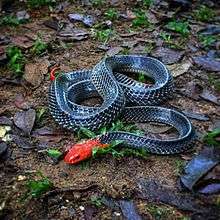Red-headed krait
| Red-headed krait | |
|---|---|
 | |
| Scientific classification | |
| Kingdom: | Animalia |
| Phylum: | Chordata |
| Class: | Reptilia |
| Order: | Squamata |
| Family: | Elapidae |
| Genus: | Bungarus |
| Species: | B. flaviceps |
| Binomial name | |
| Bungarus flaviceps Reinhardt, 1843 | |
| Synonyms | |
The red-headed krait (Bungarus flaviceps), is a large venomous elapid snake with dramatic coloration. The red-headed krait can grow to a length of up to 7 feet (2.1 m). It lives in lowland rain forest, including those on islands, but it is considered uncommon. It feeds primarily on specific snakes, probably semiaquatic and fossorial snakes. In Southeast Asia, the red-headed krait occurs in Malaysia, Thailand, and Sumatra, with a subspecies in Borneo. The venom potency is little-studied, as bites from this species are extremely rare.
Description
The species presents a very striking and distinctive coloration – namely a bright red head and tail with a black body that includes a low-lateral narrow bluish white stripe.[3] Having large, smooth scales, the general appearance of the red-headed krait is glossy and attractive. Captives will generally refuse to strike until they have been subjected to prolonged teasing.[4] The average length of a red-headed krait is 4 to 5 feet (1.2 to 1.5 m), with a maximum of 7 feet (2.1 m).[5][6] They have short, hollow fangs on their maxillary bones, with inlets at the bases and outlets near their tips. The venom is ducted to the inlet and forced through the hole at the tip of the fang.[7]
Distribution and habitat
The red-headed krait occurs in Thailand, Myanmar (Burma), Cambodia, Vietnam, western Malaysia, Pulau Tioman, and Indonesia (Bangka, Sumatra, Java, Billiton, Borneo). The subspecies B. f. baluensis is found in Malaysia (East Malaysia, Sabah).[8]
Red-headed kraits inhabit the rain forests in mountainous and hilly regions. They are hardly ever to be found in proximity to human habitations.[6]
Behaviour
They are nocturnal and partially aquatic. Once thought to feed primarily on other snakes, they are known to include skinks, lizards, frogs, caecilians, small mammals, and snake eggs in their diets. Despite their intrinsic deadliness, they are not usually considered of high risk to humans in the daytime. Variously described as sluggish, lethargic, and extremely inoffensive, they often remain hidden during the day and, when disturbed, press their heads into the ground or hide them in the flattened or rolled coils of their bodies. During the night, they are active and extremely dangerous.[9]
Venom
The red-headed krait is an extremely venomous snake, although bites are reported rarely.[10] Krait venom appears to function primarily as a neurotoxin, preventing communication across neuromuscular synapses and in paralysis and death by asphyxiation because the victims can no longer breath on their own.[9] When the venom from the red-headed krait takes effect, the most highly innervated muscles are the first to suffer: the muscle that elevates the upper eyelid and the ocular and ciliary muscles controlling the lens. Between 20 minutes and several hours after being bitten, the victim may have a real struggle to keep his or her eyelids open. This medical condition is known as bilateral ptosis and it is a classic, tell-tale sign of severe envenomation. Other common symptoms include diplopia, dysphagia, vomiting, headache, and hypersalivation. Sometime later the symptoms of paralysis tend to worsen, with progressive involvement of various muscles, including those of the jaws, in some cases, become locked. Respiratory distress may occur as a result of paralysis of the diaphragm, the main muscle controlling breathing.[7] Its venom also contains a novel postsynaptic neurotoxin, termed κ-flavitoxin, which is a potent inhibitor of nicotinic transmission in autonomic ganglia.[3] Neurotoxic symptoms may resolve naturally, or more rapidly through administration of antivenin or drugs that inactivate acetylcholinesterase, an enzyme which naturally destroys the chemical messenger carrying signals from nerves to muscles at the neuromuscular synapse.[7]
References
- ↑ Grismer, L. & Chan-Ard, T. (2012). Bungarus flaviceps. In: IUCN 2012. IUCN Red List of Threatened Species. Version 2012.2
- ↑ Reinhardt, J.T. (1843). Beskrivelse af Nogle Nye Slangearter. Det Kongelige Danske videnskabernes Selskabs Skrifter 10:233–279.
- 1 2 Tan NH, Fung SY, Ponnudurai G (2010). "Enzymatic and immunological properties of 'Bungarus flaviceps' (red-headed krait) venom". Journal of Venomous Animals and Toxins including Tropical Diseases. 16 (1): 147. doi:10.1590/S1678-91992010005000009.
- ↑ Morris P (1948). Boy's Book of Snakes. pp. 151, 152.
- ↑ U.S. Department of the Navy (1991). Poisonous Snakes of the World. p. 121. ISBN 0-486-26629-X.
- 1 2 Snakes od Thailand – Krait. Siam-info.com. Retrieved on 2013-01-03.
- 1 2 3 Menez A (2003). The Subtle Beast. p. 43. ISBN 0-415-28497-X.
- ↑ Bungarus flaviceps REINHARDT 1843. catalogueoflife.org
- 1 2 Sterling E & Hurley M (2006). Vietnam: a natural history. pp. 303–304. ISBN 0-300-10608-4.
- ↑ "Red-headed krait". Naturemalaysia.com. Retrieved 1 March 2013.
External links
- photos
- B. flaviceps at Thailand Snakes. Accessed 19 Dec 2014.
